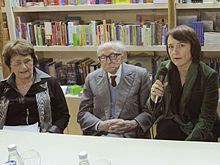|
Milica Kacin Wohinz
Milica Kacin Wohinz (née Brezigar; 12 October 1930 – 29 December 2021[1]) was a Slovenian historian best known for her seminal study on the history of the forceful Italianization of the Slovene minority in Italy (1920–1947) that took place between 1918 and 1943.[2] LifeWohinz was born in the Slovene Littoral, which was annexed by the Kingdom of Italy after World War I. At the age of twelve, she was expelled from school by the Italian Fascist regime as punishment for her father's resistance to Italianization.[2] During World War II, she joined the Liberation Front of the Slovenian People, helping Slovene partisans. After World War II and the annexation of the Slovenian Littoral to Yugoslavia in 1947, she attended the Slovene-language high schools in Postojna and Ljubljana. In 1952, she enrolled at the University of Ljubljana, where she studied history. She obtained her PhD in 1970 under the supervision of Vasilij Melik. From 1959 onward, she worked at the Institute of Contemporary History in Ljubljana. Between 1979 and 1983, she was head of the institute.[2]
Because her research topic was the history of an ethnic minority and not the history of the working class, her work was subjected to Marxist criticisms by Dušan Kermavner during Slovenia's socialist period.[2] WorkHer works on Slovene and Croat anti-Fascist resistance against Italianization are considered pioneering. She was one of the first historians to engage in thorough research of the militant anti-Fascist organization TIGR. She was member of the joint Slovenian–Italian Cultural-Historical Commission, established by the governments of the Republic of Slovenia and Republic of Italy to jointly publish the account of the historical relationship between the two peoples from 1880 to 1954 based on historiographic examination of sources.[2][3] Selected publications
References
External links |
||||||||||||||||
